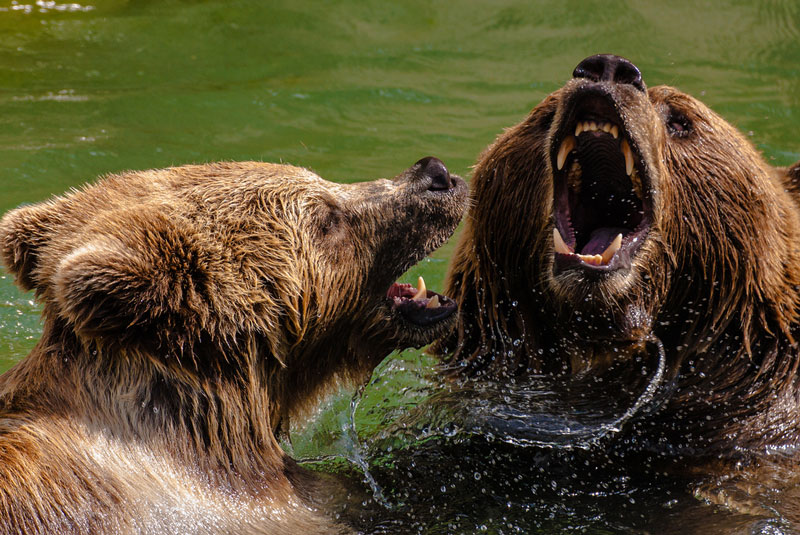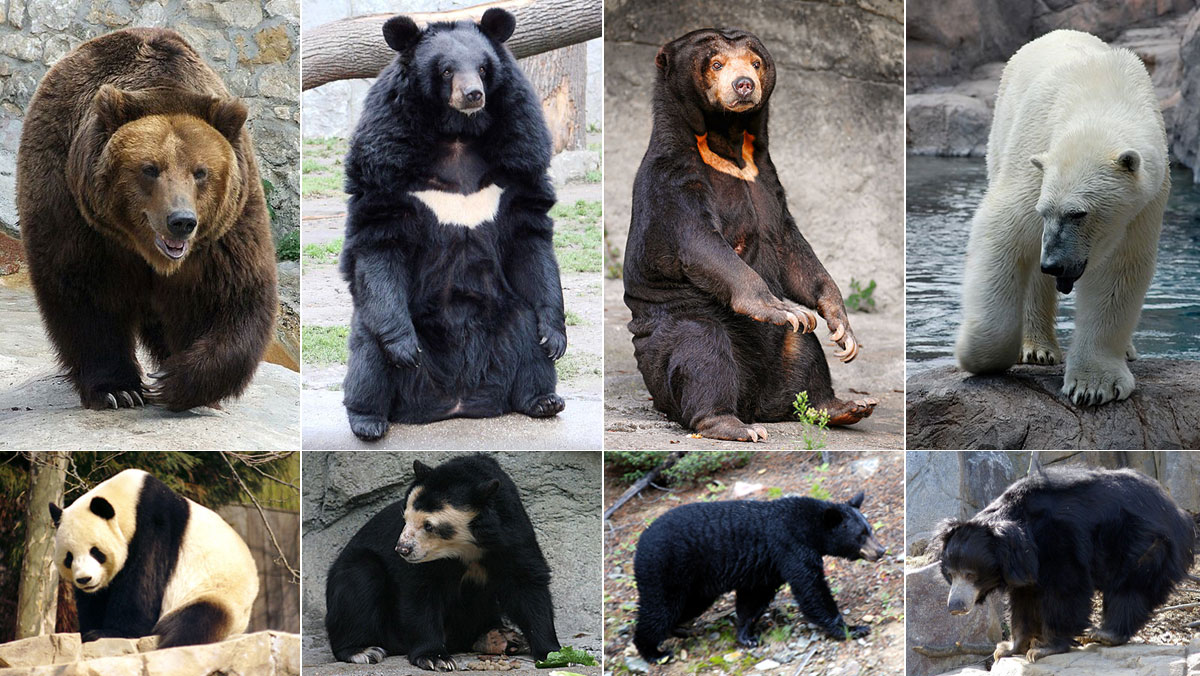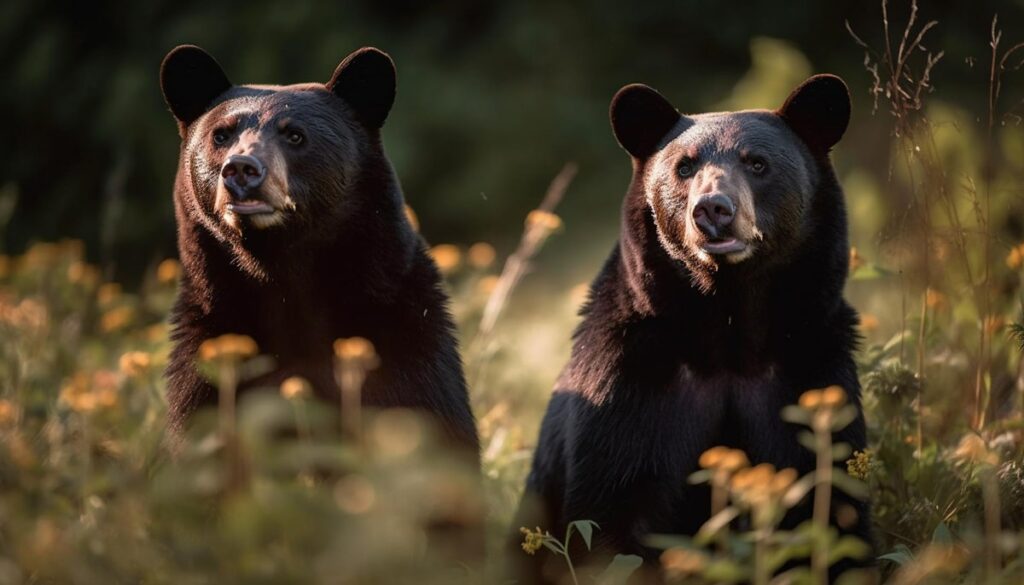1. Food: Bears will eat almost anything; bears have been observed eating rubber boots, car seats and machine oil
2. Black skin: Although polar bears‘ fur is white, their skin is black to increase their absorption of heat from the sun
3. Running: The fastest bears (black bears) can run up to 64 km/h, which is enough to catch a horse at full gallop. The fastest living human is Usain Bolt, who by comparison can run up to 43 km/h
4. Age determination: The most accurate way to determine a bear’s age is to count the number of rings under its tooth roots using a microscope
5. Oldest bear: Bears live up to 30 years in the wild. The oldest recorded bear lived in captivity and lived to be 47 years old!
6. Bear-free areas: No bears have ever lived in Australia or Antarctica (South Pole). Although no bears live in Africa today, fossils of bears have been found there. Scientists don’t know why there are no bears in Africa today
7. Winter hibernation: A bear’s normal heart rate is 40 beats per minute. During the winter, most bears go into hibernation, which is a state where the bear sleeps and its body automatically minimizes its resource consumption. During hibernation, the heart rate is 8 beats per minute. However, some scientists dispute that bears hibernate because their body temperature doesn’t drop as much as other hibernating animals. Therefore, bears sometimes refer to hibernation as ‘hibernation’ instead
8. Stool = protein: During hibernation, bears also don’t defecate as they can convert their feces into protein – a process that is not yet understood by science!
9. Native Americans: Because bears can walk short distances on their hind legs, Native Americans (in North America) called them “the animals that walk like humans”
10. Teddy bear: The American term ‘Teddy bear’ originates from US President Theodore (Teddy) Roosevelt, who refused to shoot a bear cub during a hunting trip. The incident was depicted in a cartoon and soon after, toy manufacturers adopted the term

Fact: Bears are extremely strong animals that can run up to 64 km/h, which is faster than a horse! In comparison, the fastest human – Usain Bolt – can run 43 km/h
Species and origin
- Relatives: Seals or leaf-footed seals (Pinnipedia) – which include elephant seals, sea lions, walruses and seals (as we know them) – are the closest living relatives of bears
- Species: There are 8 living bear species: the panda, spectacled bear, Malayan bear, sloth bear, polar bear, collared bear, American black bear and brown bear. In addition, there are a few subspecies that include the grizzly bear
- Endangered species: 6 out of 8 bear species are characterized as endangered by IUCN – the two species that are not considered endangered are the American black bear and the brown bear
- Largest species: The largest bear species to ever exist on Earth was the giant bear Arctodus simusthat lived in North America and went extinct around 11,000 years ago. The largest specimen found weighed around 1 ton and had a length of around 4 meters. While it’s not a fact that the giant bear lived exclusively on meat, an animal of its size would need to consume as much as 16 kg of meat per day to stay alive
- Ancestors: Bears are descended from small, insectivorous mammals called ‘miacids’ that lived 62-33 million years ago and thus existed on Earth for about 29 million years. The oldest known bear genus is the genus Ursavus, which was the size of small living dogs and was on Earth until about 29 million years ago

Here are the 8 living bear species (from left to right): Brown bear, Collared bear, Malayan bear, Polar bear, Panda, Spectacled bear, Spectacled bear, American black bear and Sloth bear
Facts about individual bear species
- Panda bears: Panda bears (Ailuropoda melanoleuca) have an extra “thumb” (which is actually an extra large sesame bone) that is used to hold onto bamboo. A panda bear can eat up to 45 kg of bamboo per day
- Lip bears: The favorite food of the sloth bear (Melursus ursinus) is termites. Sloth bears have no teeth, which enables them to easily suck termites and other insects out of their dens. They can even close off their nostrils to create a stronger suction. The sloth bear is the only bear species that is more active at night than during the day
- Malayan bears: The Malayan bear (Helarctos malayanus) has the longest claws of all bears. It also has the longest tongue, which can be up to 25 cm long!
- Grizzly bears: Approximately 98% of all grizzly bears (Ursus arctos horribilis) in the United States live in Alaska. In 2008, a man was attacked by a grizzly bear. He survived the attack by playing dead – even when the bear started gnawing on his scalp! The bear eventually lost interest and disappeared
- Koala bears: The koala bear (Phascolarctos cinereus) – despite its name – is not related to the true bears (Ursidae); it is a marsupial (Marsupialia), like kangaroos, marsupial foxes and others.
More facts about bears
- Omnivore: All bears are omnivores (i.e. omnivorous) and therefore eat both meat and plants
- Teeth set: Bears are the only large carnivores that regularly eat both meat and plants. Therefore, they have different teeth to specifically eat meat and plants
- Fur: All bears are born without fur – except polar bears and panda bears
- Fur coat: Bears have two layers of fur; 1) a short layer that keeps the bear warm and 2) a long layer that keeps water away from the skin and the short fur layer
- Tools: When bears “shed”, they may take a stone with their paws and rub it against their skin, using it as a tool to remove fur that is falling off
- Wheel legs: Bears are bow-legged, which gives them a better grip and balance
- Syn: Unlike many other mammals, bears have color vision and their eyesight is generally almost as good as that of humans
- Hearing: Bear hearing is only slightly better than human hearing
- Sense of smell: A bear’s sense of smell is around 100 times better than humans. For example, polar bears can smell prey from 32 km away and can also smell a dead seal under 90 cm of ice!
- Bile bears: In Asian countries, bile from the gallbladders of bears is used medicinally. The extraction of bile is a large commercial industry, where thousands of bears are kept captive and act as ‘bile machines’, kept alive for the sole purpose of bile (so-called ‘bile bears’)





